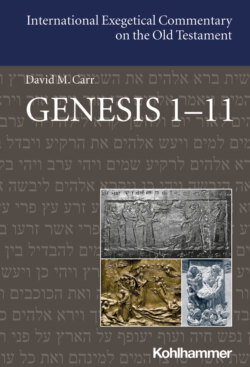Читать книгу Genesis 1-11 - David M. Carr - Страница 16
На сайте Литреса книга снята с продажи.
Layers and Dating in the Priestly Levels of the Primeval History
ОглавлениеTurning to the Priestly layer, we can identify several levels of P-like composition in Gen 1–11. Toledot BookGenesis 5 begins with what appears to be a label of an originally separate document, a “book of the descendants [תולדת tōlĕdōt] of Adam” (Gen 5:1a) that likely introduced an originally separate genealogy of primeval ancestors that was one of P’s sources. As will be discussed at more length in relation to Gen 5, this Toledot book-scroll likely included the Adam-to-Noah genealogy in most of Gen 5, a few elements regarding Noah and the flood (e.g., Gen 6:9; 7:6; 9:28–29), the Shem-to-Abraham genealogy in Gen 11:10–26, and possibly a short conclusion on Terah and his three sons in Gen 11:27a, 32*.51 As such, this Toledot booklinear genealogy formed a linear genealogy establishing Abraham’s primeval heritage, posing this ancestor of Israel as part of a genealogical line of succession extending back to the flood hero, Noah, and to the first human, Adam. Its standardized linear form and ascending numbering system generally contrasts with that used elsewhere in P.52 Moreover, the chronology of ages contained in these sections does not appear designed to coordinate with the ancestral P (and non-P) narratives that the Toledot book materials precede. These discrepancies then prompted a number of scribal changes by the early tradents of the Gen 1–11 tradition and are manifest in chronological differences between the earliest manuscripts of Genesis.
This Toledot book, perhaps along with other sources available to P, then was expanded by P into a more complete Priestly primeval history that introduced a more extended Priestly treatment of Israel’s origins.53 The Priestly SourceThe Priestly primeval history included the P creation narrative (Gen 1:1–2:3), Adam-Noah Genealogy (Gen 5*), flood narrative (Gen 6:9–9:17*), and overview of post-flood humanity deriving from Noah’s sons (in parts of Gen 10*) before bridging to Abraham (11:10–26, 27, 31–32) and the following P story of ancestors and exodus-Moses account. It is not crucial for this context to define the original end of this Priestly layer. Nevertheless, the connections of Gen 1 to the Priestly narratives about the wilderness tabernacle suggest that the P-layer beginning in Gen 1 extended at least that far.54
Like the Toledot book that it expanded, it appears that the bulk of this Priestly layer in Gen 1–11 originally stood separate in some form from the non-P material with which it is now connected.55 The originally separate character of these Priestly primeval materials provides the best explanation for why those materials form a relatively readable narrative. Moreover, as will become evident in the following commentary, key elements in the Priestly primeval history seem to have been crafted to function in an exclusively Priestly context and are only secondarily coordinated with the surrounding non-P materials. This suggests that, at least in the primeval history section, the bulk of the Priestly layer initially was composed to stand separate from the non-P materials, even as parts of that layer occasionally interact in fluid ways with those (originally separate) non-P materials.56
Finally, a conflator combined this originally separate P source with its non-P precursor, producing the complex text we now have. Notably, at least in Gen 1–11, this conflator was not neutral, but seems to have combined P and non-P in a P-like way. Priestly cast and structure in Gen 1–11As mentioned above, the conflator used the P source as the superstructure for the present text. Moreover, as will be shown in more detail in the following commentary, the conflator occasionally used secondary expansions with a Priestly cast to coordinate P and non-P materials. In this way, the present form of Gen 1–11 can be seen as resulting from a multi-stage process of Priestly and P-like composition, even as it also preserves significant blocks of originally separate non-P material.57
Dating P and its conflation with non-PAs with the non-P materials, these multiple layers of P-like and Priestly composition provide little information for dating, and conclusions on that issue relate only minimally to their exegesis. Insofar as the above-discussed layers of P presuppose the pre-P primeval history, including its flood narrative, that would suggest a dating of P sometime in the Neo-Assyrian period or later. Meanwhile, the classical Hebrew dialect in which the P Toledot book and broader primeval history is written likely would not have been produced late into the Second Temple period.58 Together, these elements would suggest a tentative dating of the P Toledot book and later P source sometime in between the (very) late monarchal and the early Persian periods.59 The conflation of P and non-P then would post-date the P source, though indicators within Gen 1–11 provide little information for further specification.60
Overview of Priestly and post-Priestly layers in Gen 1–11
Pre-Priestly “Book [scroll] of the descendants of Adam” (Toledot Book)
Gen 5:1a, 3*–28, 30–32; 6:9–10, 7:6; 9:28–29; 11:10a, 11–26, 27a, 32
Priestly expansion of that book into an expanded genealogy of the “sons of Israel”
Gen 1:1–2:3; 5:1b–2; expanded P narrative of flood (e.g., Gen 6:11–22; 9:1–17), addition of genealogical overview of post-flood peoples (e.g., Gen 10:1a, 2–7, 20, 22–23, 31–32) and continuation with materials about Abraham and his descendants (e.g., Gen 12:4b–5; 13:6 … 17:1–24).
Conflation of the Priestly expanded genealogy (= Priestly source) with Pre-P materials along with the addition of some post-P elements
Candidates for such post-P elements include the label in Gen 2:4a, some animal catalogues (e.g., Gen 6:7; 7:23) and dates (e.g., Gen 8:14) in the flood narrative, addition of Joktan and his descendants as a sideline to Peleg (Gen 10:24–30)
